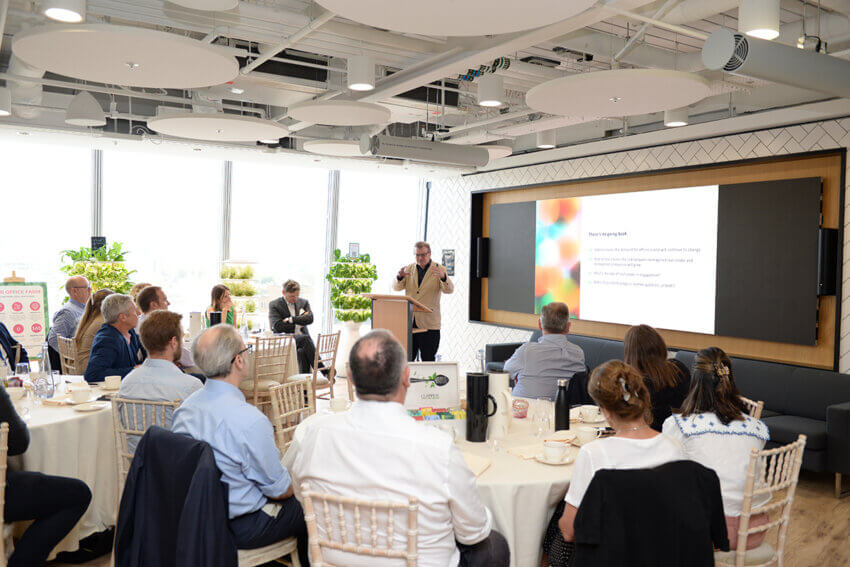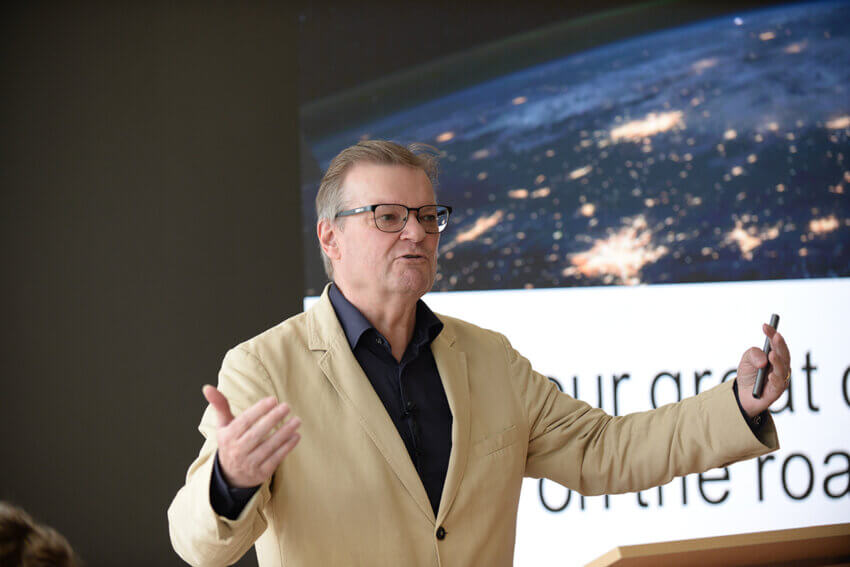Four ways to avoid the ‘brick wall’ of 2030
A brick wall. Which is getting bigger. And we’re hurtling towards it with a real risk of disaster.
That’s how leading proptech influencer, Antony Slumbers, describes the 2030 deadline, when UK carbon emissions must have reduced by 45% in line with the Paris Agreement.
Antony gave the keynote speech at Mitie’s latest Decarbonisation, Delivered briefing, where experts from organisations including Deloitte, Essex County Council and Phoenix Group gathered to learn about Estate optimisation: Proven strategies to reduce cost and carbon.
He said: “The deadline has been in place seven years. It’s seven years since David Bowie died, the Brexit referendum and President Trump was elected. Yet it feels like yesterday. Make no mistake, 2030 isn’t far off and it’s a brick wall, we are hurtling towards it – and it’s going to hurt.”
Antony went on to outline four of the greatest challenges that must be overcome if the 2030 deadline is to be reached. Let’s look at each in turn…
Challenge #1: Decarbonisation of real estate

According to the United Nations Environment Programme, the built environment is responsible for 38% of total carbon emissions, alongside 36% of energy consumption. Yet to align with a net zero scenario, the International Energy Agency states carbon emissions from building operations need to more than halve by 2030. And ironically, following the easing of Covid-19 restrictions in 2021, energy demand in buildings increased by nearly 4% – the largest annual increase in the last decade.
Antony believes a tougher official line will be taken to get buildings to where they need to be. He said: “85% of commercial properties in London do not meet 2030 standards. There will be huge penalties. You’ll get a very big bill or be stopped from renting assets. This wall is real.”
On the upside, Antony drew attention to ‘green premiums’, which mean sustainable and energy efficient buildings are more desirable to top organisations and are therefore more lucrative.
Takeaway: Decarbonisation of real estate needs to catch up – and fast. Organisations should act before they are forced to act. But there are benefits beyond saving the planet. Sustainable buildings that are pleasant to be in attract premium rents and are more valuable.
Challenge #2: Adapting to the move to hybrid, remote and distributed working
Antony outlined the huge change in the purpose of the office. Up until 2019 it was the primary place of work, a central hub for business, socialising with colleagues and team building. Downsides included the commute, the noise and distractions of open plan spaces and lack of privacy.
Then came Covid-19, and with millions of people working from home, business leaders were concerned about productivity, collaboration and communication. None of which, Antony believes, was warranted.
Antony said: “It was much ado about nothing. Good companies had no problems dealing with it… Workers now realise commuting does not have to be a daily fixture. And choice and flexibility is life-altering. Mostly people want to work in hybrid fashion. Hybrid is hard. It was easy when we were all at home or all in the office – now we’re all over the place. We need to reengineer the workplace so we’re no longer so office-centric.”
Takeaway: Accept there is no going back to five days in the office. Hybrid working, and what it means in practice, will continue to change. The most forward-thinking organisations will grasp the opportunity to hone and optimise their hybrid working strategy, making them more attractive to potential colleagues and to business partners.
Challenge #3: What will we do with the flood of obsolete buildings?
Antony revealed how challenges one and two have led to challenge three: what should be done with buildings that are not fit for purpose? A recent report showed that obsolescence presents opportunity. In the USA, 46% of the entire office stock is already or almost obsolete. Europe fares slightly better with 14% of offices obsolete. Perhaps surprisingly, overhauling these spaces to align with the demands of colleagues and the 2030 deadline is less of a challenge than it might appear.

Antony said: “We know how to solve this. People want more choice. They want less but better space…They want amenities, employee experience, technology everywhere and in everything. Sustainability comes at the top – you have to get to sustainable buildings, otherwise there is no point…We can reposition, repurpose or refurbish. And repurposing or refurbishing is the great opportunity…We’ve got to be more creative, more innovative and more visionary. None of this is going to be possible without a load of technology.”
Takeaway: Decarbonisation and hybrid working may result in excess buildings, but there is a huge opportunity to renovate and repurpose them. Applying technology-backed solutions will help organisations create new and exciting sustainable spaces for this new era in the modern built environment.
Challenge # 4: How will we save our cities from the consequences of all this change?
Antony addressed the tough times cities are facing, with increasing real estate, economic and social challenges. With so much change, how can cities ever thrive? For Antony, it’s a question of coming back to the experience offered by the built environment.
He said: “We should be starting with customer experience and working back to the real estate. To reinvigorate our cities, you have to think what it feels like to be in a great human-centric city. Safe, secure, connected and engaged. Healthy and happy, inspired and creative. Empowered and included. If cities want to remain successful and important in an increasingly distributed world, where we don’t have to be there, they need to think of those outputs. It’s a huge challenge.”
According to Antony, reinvigorating our cities depends on four key actions:
- Sustainable development
- Enhanced community and inclusion
- Embracing innovation and technology
- Better provision for culture and recreation
Takeway: The city’s survival isn’t just about businesses and working. It’s about incentivising people to come back to the city because it’s a great place to be. As Antony said: “Cities need to have a foot heavy on the pedal of innovation.” Supporting cities so they offer rich culture and recreation will see that they survive the changes of recent years and thrive for years to come.
And finally…
Concluding his speech, Antony highlighted an additional factor that will impact each of the four challenges – generative AI.
He said: “Last year, Chat GPT went from nought to 100m users in three months – the fastest growing technology of all time. It’s a general purpose technology – like electricity, the combustion engine and the internet. Everyone is going to use this in absolutely everything.”
Precisely how AI will impact real estate remains to be seen, but Antony signed off on a positive note that puts people at the centre of solving the challenge of the 2030 ‘brick wall’.
He said: “It’s going to be the opportunity of a lifetime. Doing refurbish or repurpose, you’ve got to design for people, not investors…You have to start with the customer and work back in everything. Think of people first.”
Keen to learn more about optimising your estate? Read a summary of the event.
Read next
Mitie releases e-book to tackle biggest challenges to reach net zero
Mitie’s latest e-book, released today, tackles the five biggest challenges to reaching net zero, and shares insights on how organisations can overcome each one. As the UK’s leading facilities management company, Mitie’s energy management,…

6 ways to reduce your organisation’s carbon footprint
With over half of the UK’s largest organisations committed to eliminating their carbon emissions by 2050*, there’s growing momentum to reduce our collective carbon footprint. The climate crisis, and the recognised impact of global…
FM’s role is key to delivering decarbonisation
With 60% of the UK’s large organisations now signed up to reach net zero, the race is most definitely on to adopt credible strategies and demonstrate progress on reducing emissions. However, the path is…
 Skip to content
Skip to content